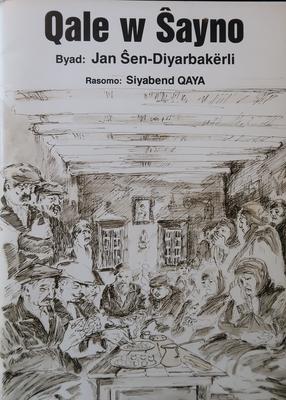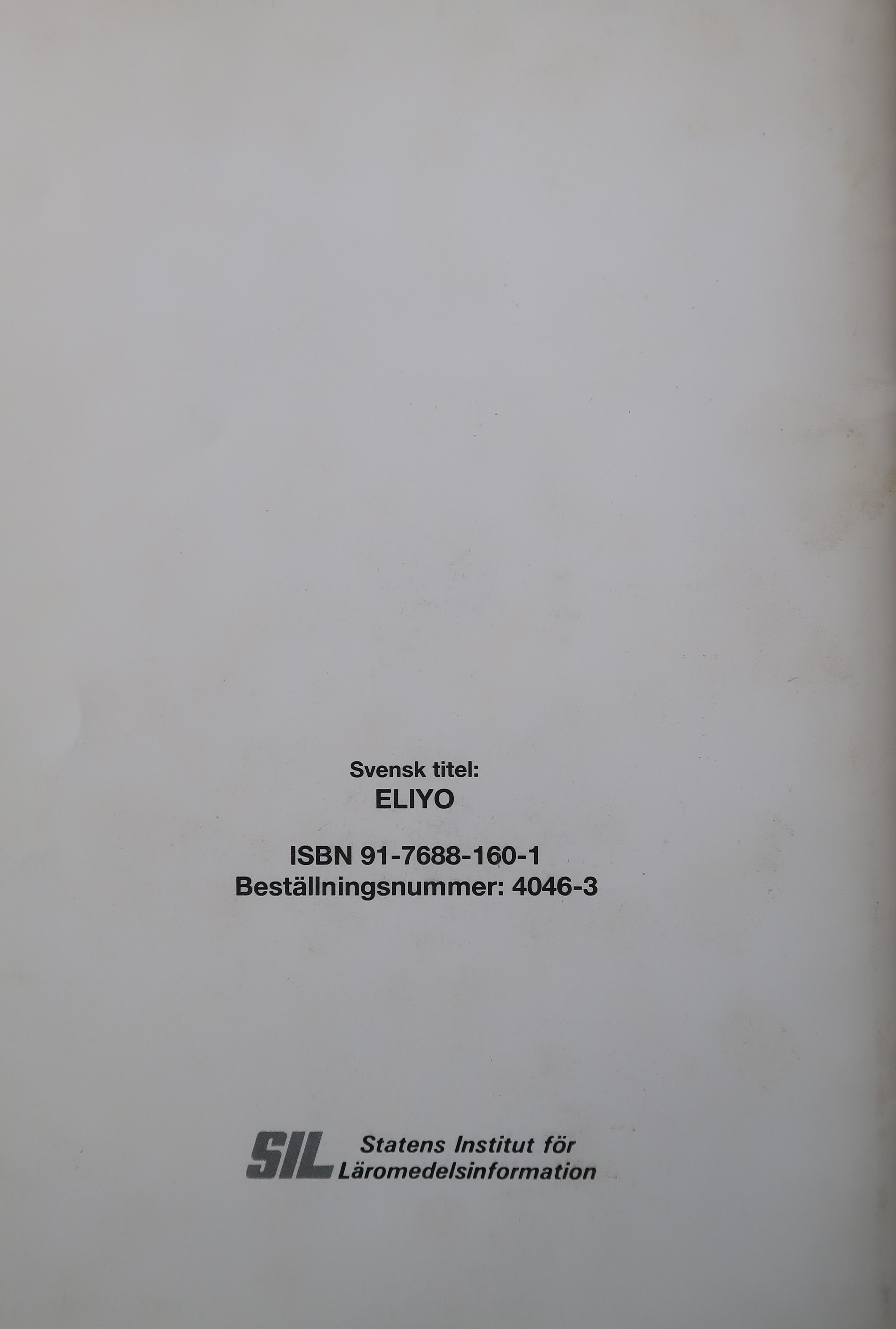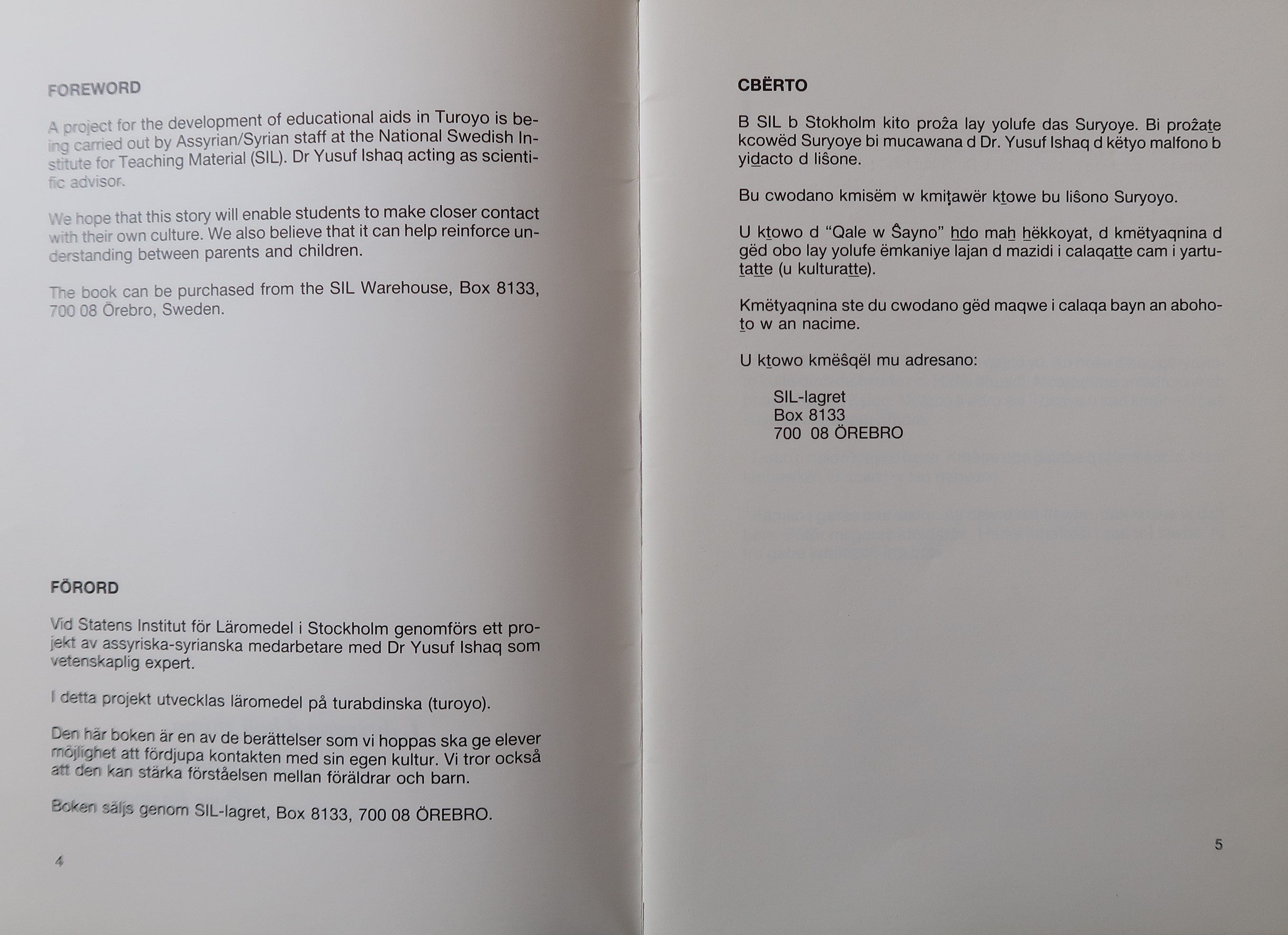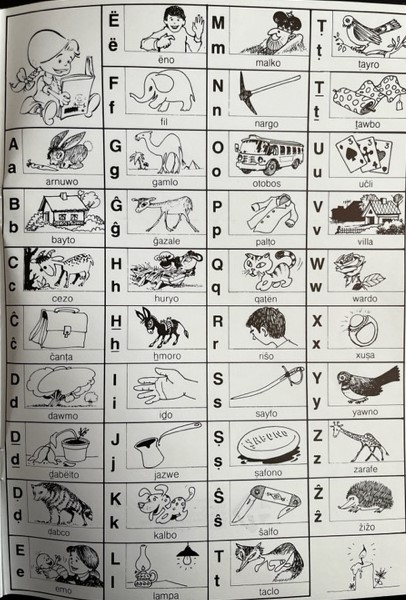Qale w Ŝayno: Şërto maş şërtoto dah haye b atran Bet-nahrin

TITLE
Qale w Ŝayno: Şërto maş şërtoto dah haye b atran Bet-nahrin (English: Sounds and Silence)
ALTERNATIVE TITLE
Eliyo (English: Elijah)
Qale w Ŝayno: Şërto maş şërtoto dah haye b atran Bet-nahrin (English: Sounds and Silence)
ALTERNATIVE TITLE
Eliyo (English: Elijah)
AUTHOR NAME 1
Jan Ŝen-Diyarbakërli
AUTHOR NAME ORIGINAL LANGUAGE 1
PUBLICATION YEAR
1989
PUBLICATION COUNTRY
Sweden
PUBLISHING ORGANISATION
National Swedish Institute for Teaching Materials
EXTRA INFO
Not a church publication, and not explicitly religious (though some of the books in the series are)
LANGUAGE 1
modern (vernacular) Northwest Aramaic (Surait)
LANGUAGE 2
Swedish
GENRE 1
Fiction & Folk stories
GENRE 2
Youth
DESCRIPTION OF ILLUSTRATION
drawings by Siyabend Qaya
NR OF PAGES
44
CITATION
Jan Ŝen-Diyarbakërli. Qale w Ŝayno: Şërto maş şërtoto dah haye b atran Bet-nahrin, Sounds and Silence. Örebro: SIL (National Swedish Institute for Teaching Materials), 1989.
Jan Ŝen-Diyarbakërli
AUTHOR NAME ORIGINAL LANGUAGE 1
PUBLICATION YEAR
1989
PUBLICATION COUNTRY
Sweden
PUBLISHING ORGANISATION
National Swedish Institute for Teaching Materials
EXTRA INFO
Not a church publication, and not explicitly religious (though some of the books in the series are)
LANGUAGE 1
modern (vernacular) Northwest Aramaic (Surait)
LANGUAGE 2
Swedish
GENRE 1
Fiction & Folk stories
GENRE 2
Youth
DESCRIPTION OF ILLUSTRATION
drawings by Siyabend Qaya
NR OF PAGES
44
CITATION
Jan Ŝen-Diyarbakërli. Qale w Ŝayno: Şërto maş şërtoto dah haye b atran Bet-nahrin, Sounds and Silence. Örebro: SIL (National Swedish Institute for Teaching Materials), 1989.
IS A TRANSLATION
No
FORM OF PUBLICATION 1
Paperback with ISBN
ISBN NUMBER
91-7688-160-1
PUBLISHED BY
SIL (National Swedish Institute for Teaching Materials)
PUBLICATION CITY
Örebro
CHURCH 1
Syriac Orthodox Church
CONTENT DESCRIPTION
The (children's/youth) story is about a village in Tur Abdin, Kfarze, with the story starting in 1962, thus at the onset of the migration, with Eliyo being the main character.
GENERAL COMMENTS
Part of a series of (at least) four books by the same author, the first two (1989) published by SIL, the two others jointly with an Assyrian/Suryoyo publisher: Bet-Froso Nsibin. From the foreword in this publication in a latinized version of the vernacular Syriac language (Turoyo) [4] provides a few lines on this ambitious but mostly unsuccessful project (as far as the introduction of this latinized version was concerned): "A project for the development of educational aids in Turoyo is being carried out by Assyrian/Syrian staff at the National Swedish Institute for Teaching Material (SIL). Dr. Yusuf Ishaq acting as scientific advisor. We hope that this story will enable students to make closer contact with their own culture. We also believe that it can help reinforce understanding between parents and children." This and the first volume are dedicated to Alyas Bar-Bas-Başomo (Ilyas Basmacioğlu) This volume includes an alphabet key, in order to help people understand the (new) way of writing the language.
No
FORM OF PUBLICATION 1
Paperback with ISBN
ISBN NUMBER
91-7688-160-1
PUBLISHED BY
SIL (National Swedish Institute for Teaching Materials)
PUBLICATION CITY
Örebro
CHURCH 1
Syriac Orthodox Church
CONTENT DESCRIPTION
The (children's/youth) story is about a village in Tur Abdin, Kfarze, with the story starting in 1962, thus at the onset of the migration, with Eliyo being the main character.
GENERAL COMMENTS
Part of a series of (at least) four books by the same author, the first two (1989) published by SIL, the two others jointly with an Assyrian/Suryoyo publisher: Bet-Froso Nsibin. From the foreword in this publication in a latinized version of the vernacular Syriac language (Turoyo) [4] provides a few lines on this ambitious but mostly unsuccessful project (as far as the introduction of this latinized version was concerned): "A project for the development of educational aids in Turoyo is being carried out by Assyrian/Syrian staff at the National Swedish Institute for Teaching Material (SIL). Dr. Yusuf Ishaq acting as scientific advisor. We hope that this story will enable students to make closer contact with their own culture. We also believe that it can help reinforce understanding between parents and children." This and the first volume are dedicated to Alyas Bar-Bas-Başomo (Ilyas Basmacioğlu) This volume includes an alphabet key, in order to help people understand the (new) way of writing the language.





